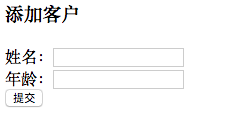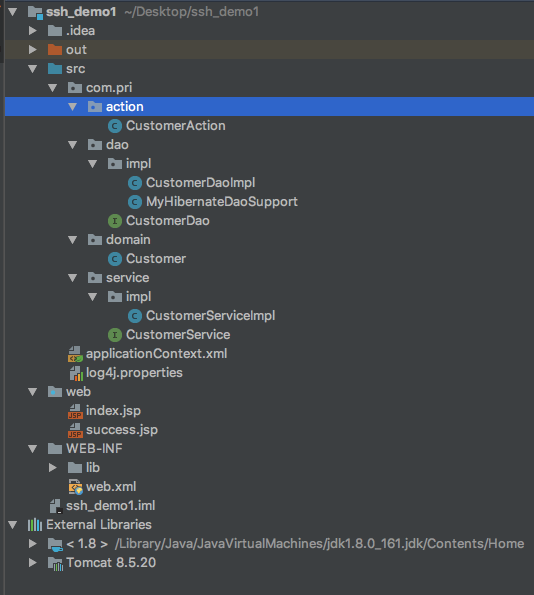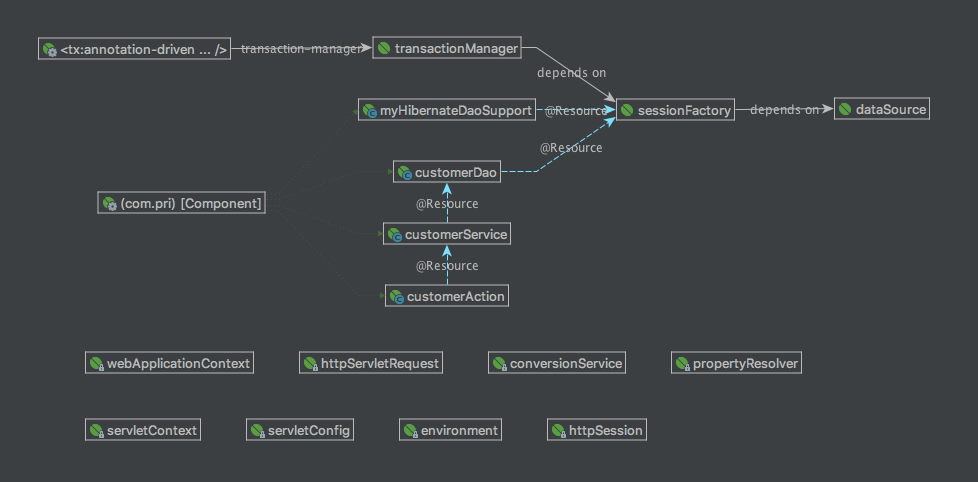基于注解的简单SSH保存用户小案例
需求:搭建SSH框架环境,使用注解进行相关的注入(实体类的注解,AOP注解、DI注入),保存用户信息
效果:

一、导依赖包

二、项目的目录结构

三、web.xml配置
<?xml version="1.0" encoding="UTF-8"?>
<web-app xmlns="http://xmlns.jcp.org/xml/ns/javaee"
xmlns:xsi="http://www.w3.org/2001/XMLSchema-instance"
xsi:schemaLocation="http://xmlns.jcp.org/xml/ns/javaee http://xmlns.jcp.org/xml/ns/javaee/web-app_3_1.xsd"
version="3.1"> <!--懒加载过滤器,解决懒加载问题-->
<filter>
<filter-name>openSession</filter-name>
<filter-class>org.springframework.orm.hibernate5.support.OpenSessionInViewFilter</filter-class>
</filter>
<filter-mapping>
<filter-name>openSession</filter-name>
<url-pattern>*.action</url-pattern>
</filter-mapping> <!-- struts2的前端控制器 -->
<filter>
<filter-name>struts</filter-name>
<filter-class>org.apache.struts2.dispatcher.ng.filter.StrutsPrepareAndExecuteFilter</filter-class>
</filter>
<filter-mapping>
<filter-name>struts</filter-name>
<url-pattern>/*</url-pattern>
</filter-mapping> <!-- spring 创建监听器 -->
<listener>
<listener-class>org.springframework.web.context.ContextLoaderListener</listener-class>
</listener> <context-param>
<param-name>contextConfigLocation</param-name>
<param-value>classpath:applicationContext.xml</param-value>
</context-param> </web-app>
四、applicationContext.xml配置
<?xml version="1.0" encoding="UTF-8"?>
<beans xmlns="http://www.springframework.org/schema/beans"
xmlns:xsi="http://www.w3.org/2001/XMLSchema-instance"
xmlns:tx="http://www.springframework.org/schema/tx"
xmlns:contex="http://www.springframework.org/schema/context"
xsi:schemaLocation="http://www.springframework.org/schema/beans
http://www.springframework.org/schema/beans/spring-beans.xsd
http://www.springframework.org/schema/tx
http://www.springframework.org/schema/tx/spring-tx.xsd
http://www.springframework.org/schema/context
http://www.springframework.org/schema/context/spring-context.xsd"> <!-- 打开注解扫描开关 -->
<contex:component-scan base-package="com.pri"/> <!-- 以下是属于hibernate的配置 -->
<bean id="dataSource" class="com.mchange.v2.c3p0.ComboPooledDataSource">
<property name="driverClass" value="com.mysql.jdbc.Driver"/>
<property name="jdbcUrl" value="jdbc:mysql:///ssh_demo1?useSSL=false"/>
<property name="user" value="root"/>
<property name="password" value=""/>
</bean> <bean id="sessionFactory" class="org.springframework.orm.hibernate5.LocalSessionFactoryBean">
<!--1、核心配置-->
<property name="dataSource" ref="dataSource"/> <!-- 2、可选配置-->
<property name="hibernateProperties">
<props>
<prop key="hibernate.dialect">org.hibernate.dialect.MySQL5Dialect</prop>
<prop key="hibernate.show_sql">true</prop>
<prop key="hibernate.format_sql">true</prop>
<prop key="hibernate.hbm2ddl.auto">update</prop>
</props>
</property>
<!-- 3、扫描映射文件 -->
<property name="packagesToScan" value="com.pri.domain"></property>
</bean> <!--开启事务控制-->
<bean id="transactionManager" class="org.springframework.orm.hibernate5.HibernateTransactionManager">
<property name="sessionFactory" ref="sessionFactory"></property>
</bean>
<tx:annotation-driven transaction-manager= "transactionManager"/>
</beans>
五、log4j.properties配置
#设置日志记录到控制台的方式
log4j.appender.std=org.apache.log4j.ConsoleAppender
#out以黑色字体输出,err以红色字体输出
log4j.appender.std.Target=System.err
log4j.appender.std.layout=org.apache.log4j.PatternLayout
log4j.appender.std.layout.ConversionPattern=%d{yyyy-MM-dd HH:mm:ss} %5p %c{1}:%L - %m%n
#设置日志记录到文件的方式
log4j.appender.file=org.apache.log4j.FileAppender
#日志文件路径文件名
log4j.appender.file.File=mylog.log
#日志输出的格式
log4j.appender.file.layout=org.apache.log4j.PatternLayout
log4j.appender.file.layout.ConversionPattern=%d{ABSOLUTE} %5p %c{1}:%L - %m%n
#日志输出的级别,以及配置记录方案,级别:error > warn > info>debug>trace
log4j.rootLogger=info, std, file
六、页面代码
index.jsp
<%@ page contentType="text/html;charset=UTF-8" language="java" %>
<html>
<head>
<title>$Title$</title>
</head>
<body>
<h3>添加客户</h3>
<form action="${ pageContext.request.contextPath }/customerAction_save" method="post">
姓名:<input type="text" name="name" /><br/>
年龄:<input type="text" name="age" /><br/>
<input type="submit" value="提交"/><br/>
</form>
</body>
</html>
success.jsp
<%@ page contentType="text/html;charset=UTF-8" language="java" %>
<html>
<head>
<title>首页</title>
</head>
<body>
<h1>保存成功!</h1>
</body>
</html>
七、实体层代码
package com.pri.domain; import javax.persistence.*; @Entity
@Table(name = "customer")
public class Customer {
@Id
@Column(name = "userId")
@GeneratedValue(strategy = GenerationType.IDENTITY)
private Integer userId; @Column(name = "name")
private String name;
@Column(name = "age")
private Integer age; public Integer getUserId() {return userId; } public void setUserId(Integer userId) {this.userId = userId;} public String getName() {return name;} public void setName(String name) {this.name = name;} public Integer getAge() {return age;} public void setAge(Integer age) {this.age = age;}
}
八、action层代码
package com.pri.action; import com.pri.domain.Customer;
import com.pri.service.CustomerService;
import com.opensymphony.xwork2.ActionSupport;
import com.opensymphony.xwork2.ModelDriven;
import org.apache.struts2.convention.annotation.Action;
import org.apache.struts2.convention.annotation.Namespace;
import org.apache.struts2.convention.annotation.ParentPackage;
import org.apache.struts2.convention.annotation.Result;
import org.springframework.context.annotation.Scope;
import org.springframework.stereotype.Controller;
import javax.annotation.Resource; @Controller("customerAction")
@ParentPackage(value = "struts-default")
@Scope("prototype")
@Namespace(value = "/")
public class CustomerAction extends ActionSupport implements ModelDriven<Customer>{ private Customer customer; @Resource(name = "customerService")
private CustomerService customerService; @Override
public Customer getModel() {
if (customer == null ){
customer = new Customer();
}
return customer;
} @Action(value = "customerAction_save",
results = {@Result(name = SUCCESS,type = "redirect",location = "/success.jsp")})
public String save(){
customerService.save(customer);
return SUCCESS;
}
}
九、service层代码
package com.pri.service;
import com.pri.domain.Customer;
public interface CustomerService {
void save(Customer user);
}
//=======================================
package com.pri.service.impl;
import com.pri.domain.Customer;
import com.pri.dao.CustomerDao;
import com.pri.service.CustomerService;
import org.springframework.stereotype.Service;
import org.springframework.transaction.annotation.Transactional;
import javax.annotation.Resource;
@Service("customerService")
@Transactional
public class CustomerServiceImpl implements CustomerService {
@Resource(name = "customerDao")
private CustomerDao customerDao;
@Override
public void save(Customer customer) {
customerDao.save(customer);
}
}
十、dao层代码
package com.pri.dao;
import com.pri.domain.Customer;
public interface CustomerDao {
void save(Customer customer);
}
//==================================================================
package com.pri.dao.impl;
import org.hibernate.SessionFactory;
import org.springframework.orm.hibernate5.support.HibernateDaoSupport;
import org.springframework.stereotype.Component;
import javax.annotation.Resource;
@Component("myHibernateDaoSupport")
public class MyHibernateDaoSupport extends HibernateDaoSupport {
@Resource(name = "sessionFactory")
public void setSuperSessionFactory(SessionFactory sessionFactory){
super.setSessionFactory(sessionFactory);
}
}
//=================================================
package com.pri.dao.impl;
import com.pri.dao.CustomerDao;
import com.pri.domain.Customer;
import org.springframework.stereotype.Repository;
@Repository("customerDao")
public class CustomerDaoImpl extends MyHibernateDaoSupport implements CustomerDao {
@Override
public void save(Customer customer) {
getHibernateTemplate().save(customer);
}
}
十一、Spring Beans Dependencies

基于注解的简单SSH保存用户小案例的更多相关文章
- Netty学习——基于netty实现简单的客户端聊天小程序
Netty学习——基于netty实现简单的客户端聊天小程序 效果图,聊天程序展示 (TCP编程实现) 后端代码: package com.dawa.netty.chatexample; import ...
- springboot+ehcache 基于注解实现简单缓存demo
1.加入maven依赖 <dependency> <groupId>org.springframework.boot</groupId> <artifactI ...
- jackson基于注解的简单使用
Jackson提供了一系列注解,方便对JSON序列化和反序列化进行控制,下面介绍一些常用的注解. 1.@JsonIgnore 此注解用于属性上,作用是进行JSON操作时忽略该属性. 2.@JsonFo ...
- 10 Spring框架--基于注解和xml的配置的应用案例
1.项目结构 2.基于xml配置的项目 <1>账户的业务层接口及其实现类 IAccountService.java package lucky.service; import lucky. ...
- Spring中基于注解的IOC(二):案例与总结
2.Spring的IOC案例 创建maven项目 导入依赖 pom.xml xmlns:xsi="http://www.w3.org/2001/XMLSchema-instance" ...
- Hibernate基于注解annotation的配置
Annotation在框架中是越来越受欢迎了,因为annotation的配置比起XML的配置来说方便了很多,不需要大量的XML来书写,方便简单了很多,只要几个annotation的配置,就可以完成我们 ...
- 菜鸟学SSH(十七)——基于注解的SSH将配置精简到极致
很早之前就想写一篇关于SSH整合的博客了,但是一直觉得使用SSH的时候那么多的配置文件,严重破坏了我们代码整体性,比如你要看两个实体的关系还得对照*.hbm.xml文件,要屡清一个Action可能需要 ...
- Servlet之保存用户偏好设置简单功能的实现
写在前面: 先来陈述一下为什么会有这样一个需求和这篇博文. 这是公司的一个项目,我们负责前端,后台服务由其他公司负责.该系统有一个系统偏好设置模块,用户可以设置系统的背景图片等系统样式,因为这是一个比 ...
- 8 -- 深入使用Spring -- 4...5 AOP代理:基于注解的“零配置”方式
8.4.5 基于注解的“零配置”方式 AspectJ允许使用注解定义切面.切入点和增强处理,而Spring框架则可识别并根据这些注解来生成AOP代理.Spring只是使用了和AspectJ 5 一样的 ...
随机推荐
- HBase二级索引的设计
摘要 最近做的一个项目涉及到了多条件的组合查询,数据存储用的是HBase,恰恰HBase对于这种场景的查询特别不给力,一般HBase的查询都是通过RowKey(要把多条件组合查询的字段都拼接在RowK ...
- item pipeline 实例:爬取360摄像图片
生成项目 scrapy startproject image360 cd Image360 && scrapy genspider images images.so.com 一. 构 ...
- Antd 初识
mark 参考 antd - 官网:Ant Design Pro: Ant Design - github:Ant Design pro - github:
- linux上搭建nginx+php+mysql环境详细讲解
1.mysql安装 #安装编译环境 yum install -y gcc gcc-c++ gcc-devel g++ g++-devel; yum install -y wget yum instal ...
- SHELL脚本进阶
一.读取参数 $0 程序名称$1 第一个参数$2 第二个参数,依次类推可以使用 basename 来读取程序名称:basename $0 可以使用 dirname 来读取第一个参数的目录:dirnam ...
- 阿里云服务器18个数据中心测试IP地址以及测试方法
我们用户在选择阿里云服务器的时候是不是感觉阿里云的数据中心太多太多,确实阿里云服务器机房是有很多,国外国外机房大约有18个,甚至更多,因为还在不断的增加机房.对于商家而言增加不同的机房可以满足不同的项 ...
- Python全栈开发:list、元祖常用方法操作
列表[] 索引与切片#例题#li = ['yijiajun',[1,3,5,7,9],'zhangliang','zhaoritian','sunwukong'] # #例子1 找出列表中索引为0的元 ...
- LINQ入门教程之各种标准查询操作符(二)
续上篇LINQ入门教程之各种标准查询操作符(一) LINQ入门教程之各种标准查询操作符(二) 7. 聚合操作符 8. 集合操作符 9. 生成操作符 #region 生成操作符 即从现有序列的值中 ...
- (转)Python 字符串格式化 str.format 简介
原文:https://www.cnblogs.com/wilber2013/p/4641616.html http://blog.konghy.cn/2016/11/25/python-str-for ...
- c++ 网络编程课设入门超详细教程 ---目录
原文作者:aircraft 原文链接:https://www.cnblogs.com/DOMLX/p/9663167.html c++ 网络编程(一)TCP/UDP windows/linux 下入门 ...
